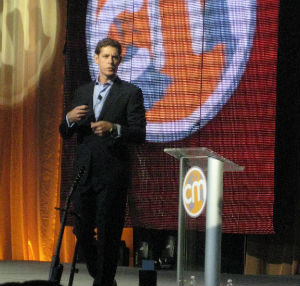 The Day 2 afternoon keynote address at Content Marketing World in Cleveland was given by Jonathan Lister, the Vice President of Sales Marketing Solutions for North America at LinkedIn, speaking on why their company is going “all-in” with content marketing.
The Day 2 afternoon keynote address at Content Marketing World in Cleveland was given by Jonathan Lister, the Vice President of Sales Marketing Solutions for North America at LinkedIn, speaking on why their company is going “all-in” with content marketing.
This is an incredible time for both LinkedIn and for TopRank Online Marketing, since TopRank provides content marketing services for LinkedIn Marketing Solutions.
Did you know? Consumers are 60% through the decision making process before ever reaching out to a business.
“LinkedIn is a members-first organization –making members happy and satisfied is more important than anything we do.”
What people do in their professional lives is very different from what they do in their personal lives. At work during the day, they’re performing work functions online, but when they get home they’re using the internet for more personal communication and research. LinkedIn realized that the thing they could do to better service their members was to create better content to connect the personal and professional worlds during a user’s free time.
“Marketers need to adopt a members-first approach to content. Your audience doesn’t need to be sold to – they need information.”
LinkedIn developed a system where the content a user was shown would be custom-tailored to the industry they’re in. They employed the 150 most influential people in the world to blog for them. They noticed that the first piece, written by Bill Gates, 3 Things I’ve learned from Warren Buffet generated thousands of rich and qualified comments, and continued to find this when thought leaders from the various industry spaces wrote pieces tailored to, and marketed to, the proper industry audiences.
“Think about changing the mantra from always be closing, to always be helping.”
87% of marketers use Social Media for content distribution but only 50% think it’s working.
In keeping with the “be helpful” mantra, LinkedIn truly believes that part of the key to being helpful is being relevant. You can’t treat your audience as a prospect or number and then segment them when it comes to content – if you want to engage them and create a conversation with them, you have to treat them as people.
“Speak to the dog, in the language of the dog, about what’s in the heart of the dog.” – Roy Williams
“Moving from information to insight creates content relevance. We don’t need more content – we need more relevant content.”
So LinkedIn set out to create more relevant content, understand their audience in their context, then peel away the excess information to turn quantitative into qualitative. Now once you’ve done all of that, you have to do it in real time.
There are three types of real-time relevant content:
- Content that’s waiting for the moment – Marketers draft content and then wait to release it to piggyback on a trend, or they release new information while there’s a lull from their competitor and they have the audience’s full attention.
- Content that’s in the moment – Responding to a real-time message like when Oreo released “Dunk in the Dark” or when Smart Car USA responded to a tweet about bird crap with an analytical infographic.
- Content that is Anticipating the moment – When a company predicts a product that people will like before they ask for it. (For example, did anyone request that Proctor & Gamble introduce the Swiffer? And look how that’s going for them!)
Is your company creating all three kinds?
There are easy measures to know whether your content is relevant – increased referral traffic, increased social engagement, and higher quality leads – and LinkedIn finds these successful outcomes will result from the pieces of content where they’re asking themselves – “Is it helpful?”
“The future of content marketing is in your hands. Do you want to keep selling to people who don’t want to be sold to? Or do you want to be helpful?”


